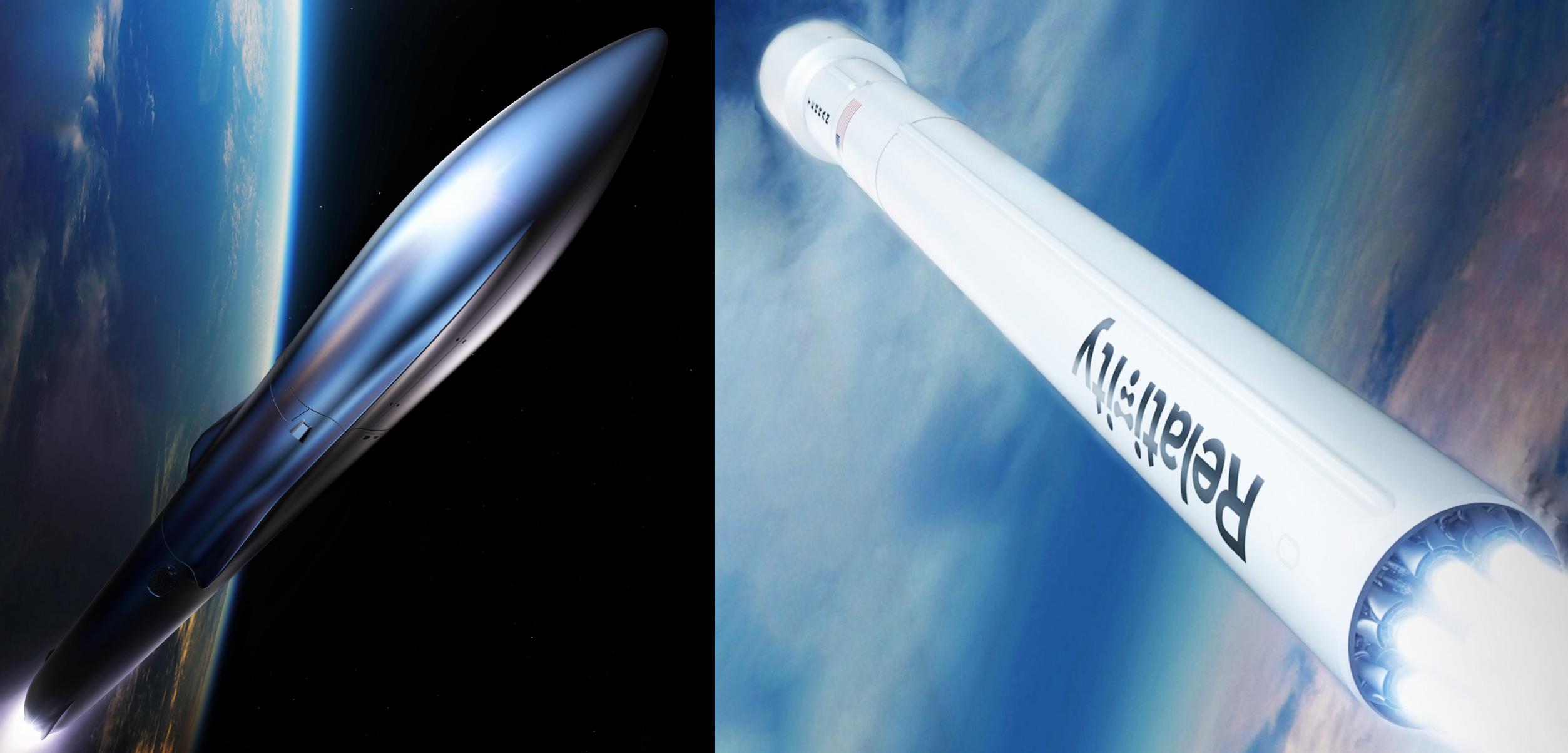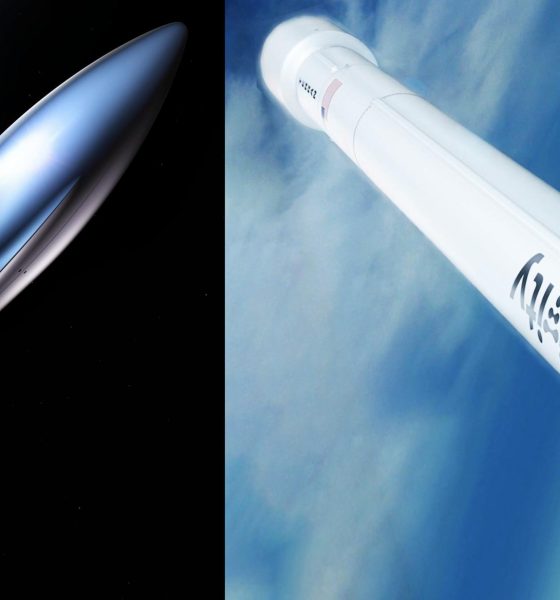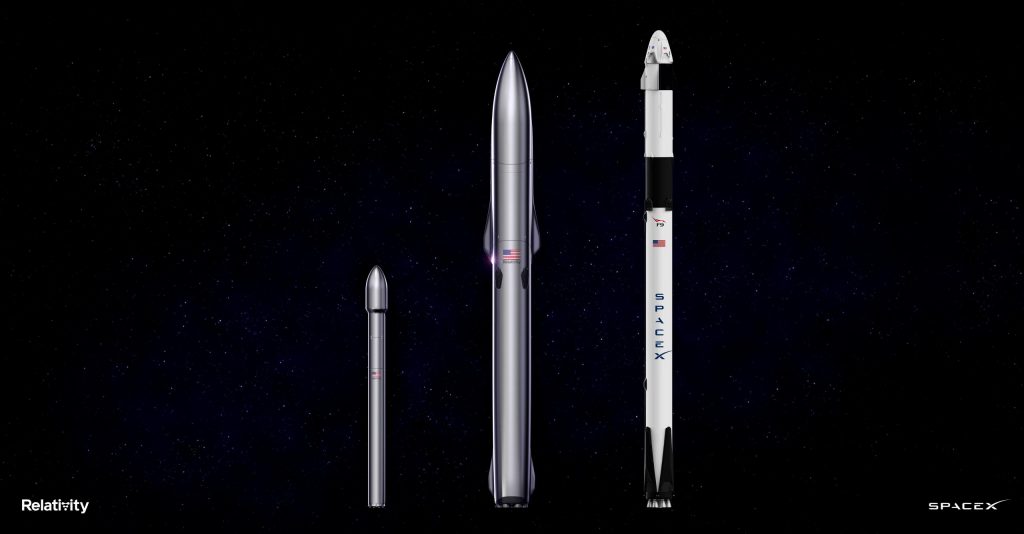

News
Relativity Space reveals plans to rapidly upgrade 3D-printed Terran 1 rocket
Relativity Space has announced that it will only launch the first version of its small Terran 1 rocket a handful of times before upgrading the vehicle in ways that will aid work on a much larger, fully reusable rocket.
Relativity co-founder and CEO Tim Ellis revealed the news in a recent interview, explaining that while the original Terran 1 rocket is still an integral part of the company’s vision and success, it will mainly serve as a bridge to the larger and more capable Terran R – a rare rocket with the potential to compete head-to-head with SpaceX’s Falcon 9.
“We’ve always envisioned Terran 1 being a development platform,” stated Ellis in an interview with Ars Technica. The Terran 1 rocket, which is thrust into orbit using nine proprietary Aeon-1 engines is designed to carry payloads into Low Earth Orbit (LEO). The first launch of Terran 1 is anticipated to take place by the end of 2022, with Ellis stating that Relativity is “definitely launching this year.” Terran 1’s first launch won’t carry payloads, indicating its experimental nature, but it will be serving as the startup’s first orbital launch attempt.
Assuming the rocket’s debut is mostly successful, Terran 1’s second mission will carry a “Venture Class Launch Services” small satellite payload for NASA. The third and final mission for the first version of Terran 1 will also carry payloads, though Relativity has yet to reveal its customer(s).
Once completed, Ellis says Relativity will shift its focus away from the Aeon-1 engine setup on Terran 1’s booster. Instead, they will remove the nine Aeon-1 engines from the vehicle and replace them with a single 135-ton-thrust (~300,000 lbf) Aeon-R engine – seven of which will eventually power Terran R’s reusable booster.
When asked why the startup didn’t simply start with the Aeon-R engine, Ellis noted that developing a booster with nine smaller Aeon-1 engines was “definitely not the optimum choice in hindsight to get to orbit as simply and quickly as possible for the Terran 1 program.” He added, “But it’s been part of our plans to do a much larger reusable rocket for a long time. So we chose to do liquid oxygen and liquid methane engines, as well as the nine-engine configuration on Terran 1 so that we could learn as a company how to do something that complex early on before we had to go build this 20,000-kilogram payload-to-orbit vehicle.”
There are many benefits that come from using the single Aeon-R engine on Terran 1, including reduced cost, processes, and more capable rockets. By scaling down the number of engines from nine Aeon-1s to one Aeon-Rs, they are also scaling down the number of turbopumps, which will reduce labor and cost. The Aeon-R engine, seven of which will power the Terran R rocket, will also produce nearly ~300,000 pounds of thrust. This will provide the company with more capable small launch vehicles.

Ultimately, Relativity’s goal is to launch Terran R, a much larger, more powerful, and (in theory) fully-reusable rocket. Ellis stated that both the first and second stages of Terran R will be reusable, potentially allowing the rocket to directly compete with Falcon 9 – and maybe even the company’s fully-reusable Starship. SpaceX’s workhorse rocket has successfully launched 142 times and the company appears to be more confident in it than ever before. In 2022 alone, SpaceX hopes to launch an average of one Falcon rocket per week.
Despite the fact that SpaceX successfully landed its first Falcon booster in 2015 and reused a booster on a commercial launch in 2017, traditional competitors like Arianespace and ULA have done little to respond and continue to develop new rockets – Vulcan Centaur and Ariane 6 – that are fully expendable, substantially more expensive than SpaceX’s offerings, and still without a clear path to reusability. Alongside Blue Origin’s New Glenn vehicle and Rocket Lab’s Neutron, Relativity’s Terran R rocket may actually be able to compete with Falcon 9.
Ellis further revealed that Terran R already has at least one signed customer, with many others expressing interest behind the scenes. Though the company’s official timeline is incredibly ambitious, Relativity says Terran R could launch as early as 2024, giving the company less than three years to develop the giant rocket from scratch.
It is still unclear how either stage of Terran R will be recovered, nor how the rocket will integrate into the already existing launch facilities being built for Terran 1 at the Cape Canaveral Space Force Station’s (CCSFS) LC-16 pad. Nonetheless, Ellis and the entire Relativity team seem determined to deliver on their promises. Ellis didn’t shy away from bold and undeniable claims, either, stating that “we are definitely launching this year.” “I have no doubt about that…at this point, barring an act of nature or something going seriously wrong in stage testing.”

Elon Musk
Elon Musk’s X will start using a Tesla-like software update strategy
The initiative seems designed to accelerate updates to the social media platform, while maintaining maximum transparency.

Elon Musk’s social media platform X will adopt a Tesla-esque approach to software updates for its algorithm.
The initiative seems designed to accelerate updates to the social media platform, while maintaining maximum transparency.
X’s updates to its updates
As per Musk in a post on X, the social media company will be making a new algorithm to determine what organic and advertising posts are recommended to users. These updates would then be repeated every four weeks.
“We will make the new 𝕏 algorithm, including all code used to determine what organic and advertising posts are recommended to users, open source in 7 days. This will be repeated every 4 weeks, with comprehensive developer notes, to help you understand what changed,” Musk wrote in his post.
The initiative somewhat mirrors Tesla’s over-the-air update model, where vehicle software is regularly refined and pushed to users with detailed release notes. This should allow users to better understand the details of X’s every update and foster a healthy feedback loop for the social media platform.
xAI and X
X, formerly Twitter, has been acquired by Elon Musk’s artificial intelligence startup, xAI last year. Since then, xAI has seen a rapid rise in valuation. Following the company’s the company’s upsized $20 billion Series E funding round, estimates now suggest that xAI is worth tens about $230 to $235 billion. That’s several times larger than Tesla when Elon Musk received his controversial 2018 CEO Performance Award.
As per xAI, the Series E funding round attracted a diverse group of investors, including Valor Equity Partners, Stepstone Group, Fidelity Management & Research Company, Qatar Investment Authority, MGX, and Baron Capital Group, among others. Strategic partners NVIDIA and Cisco Investments also continued support for building the world’s largest GPU clusters.
News
Tesla FSD Supervised wins MotorTrend’s Best Driver Assistance Award
The decision marks a notable reversal for the publication from prior years, with judges citing major real-world improvements that pushed Tesla’s latest FSD software ahead of every competing ADAS system.

Tesla’s Full Self-Driving (Supervised) system has been named the best driver-assistance technology on the market, earning top honors at the 2026 MotorTrend Best Tech Awards.
The decision marks a notable reversal for the publication from prior years, with judges citing major real-world improvements that pushed Tesla’s latest FSD software ahead of every competing ADAS system. And it wasn’t even close.
MotorTrend reverses course
MotorTrend awarded Tesla FSD (Supervised) its 2026 Best Tech Driver Assistance title after extensive testing of the latest v14 software. The publication acknowledged that it had previously criticized earlier versions of FSD for erratic behavior and near-miss incidents, ultimately favoring rivals such as GM’s Super Cruise in earlier evaluations.
According to MotorTrend, the newest iteration of FSD resolved many of those shortcomings. Testers said v14 showed far smoother behavior in complex urban scenarios, including unprotected left turns, traffic circles, emergency vehicles, and dense city streets. While the system still requires constant driver supervision, judges concluded that no other advanced driver-assistance system currently matches its breadth of capability.
Unlike rival systems that rely on combinations of cameras, radar, lidar, and mapped highways, Tesla’s FSD operates using a camera-only approach and is capable of driving on city streets, rural roads, and freeways. MotorTrend stated that pure utility, the ability to handle nearly all road types, ultimately separated FSD from competitors like Ford BlueCruise, GM Super Cruise, and BMW’s Highway Assistant.
High cost and high capability
MotorTrend also addressed FSD’s pricing, which remains significantly higher than rival systems. Tesla currently charges $8,000 for a one-time purchase or $99 per month for a subscription, compared with far lower upfront and subscription costs from other automakers. The publication noted that the premium is justified given FSD’s unmatched scope and continuous software evolution.
Safety remained a central focus of the evaluation. While testers reported collision-free operation over thousands of miles, they noted ongoing concerns around FSD’s configurable driving modes, including options that allow aggressive driving and speeds beyond posted limits. MotorTrend emphasized that, like all Level 2 systems, FSD still depends on a fully attentive human driver at all times.
Despite those caveats, the publication concluded that Tesla’s rapid software progress fundamentally reshaped the competitive landscape. For drivers seeking the most capable hands-on driver-assistance system available today, MotorTrend concluded Tesla FSD (Supervised) now stands alone at the top.
News
Elon Musk’s Grokipedia surges to 5.6M articles, almost 79% of English Wikipedia
The explosive growth marks a major milestone for the AI-powered online encyclopedia, which was launched by Elon Musk’s xAI just months ago.

Elon Musk’s Grokipedia has grown to an impressive 5,615,201 articles as of today, closing in on 79% of the English Wikipedia’s current total of 7,119,376 articles.
The explosive growth marks a major milestone for the AI-powered online encyclopedia, which was launched by Elon Musk’s xAI just months ago. Needless to say, it would only be a matter of time before Grokipedia exceeds English Wikipedia in sheer volume.
Grokipedia’s rapid growth
xAI’s vision for Grokipedia emphasizes neutrality, while Grok’s reasoning capabilities allow for fast drafting and fact-checking. When Elon Musk announced the initiative in late September 2025, he noted that Grokipedia would be an improvement to Wikipedia because it would be designed to avoid bias.
At the time, Musk noted that Grokipedia “is a necessary step towards the xAI goal of understanding the Universe.”
Grokipedia was launched in late October, and while xAI was careful to list it only as Version 0.1 at the time, the online encyclopedia immediately earned praise. Wikipedia co-founder Larry Sanger highlighted the project’s innovative approach, noting how it leverages AI to fill knowledge gaps and enable rapid updates. Netizens also observed how Grokipedia tends to present articles in a more objective manner compared to Wikipedia, which is edited by humans.
Elon Musk’s ambitious plans
With 5,615,201 total articles, Grokipedia has now grown to almost 79% of English Wikipedia’s article base. This is incredibly quick, though Grokipedia remains text-only for now. xAI, for its part, has now updated the online encyclopedia’s iteration to v0.2.
Elon Musk has shared bold ideas for Grokipedia, including sending a record of the entire knowledge base to space as part of xAI’s mission to preserve and expand human understanding. At some point, Musk stated that Grokipedia will be renamed to Encyclopedia Galactica, and it will be sent to the cosmos.
“When Grokipedia is good enough (long way to go), we will change the name to Encyclopedia Galactica. It will be an open source distillation of all knowledge, including audio, images and video. Join xAI to help build the sci-fi version of the Library of Alexandria!” Musk wrote, adding in a later post that “Copies will be etched in stone and sent to the Moon, Mars and beyond. This time, it will not be lost.”








